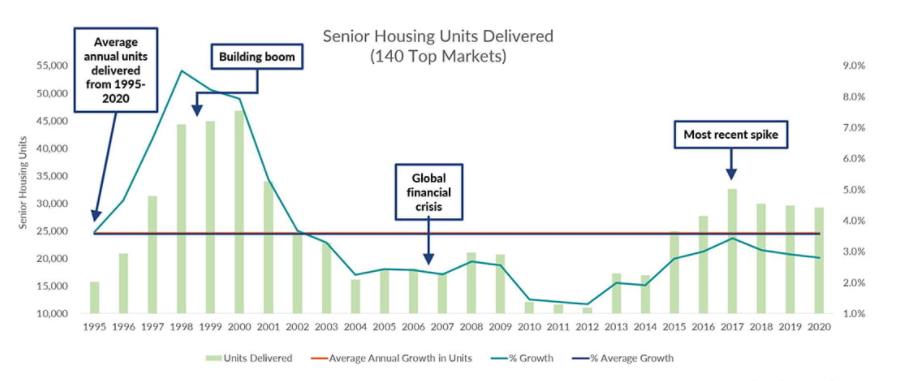
Sign up to receive latest insights & updates in technology, AI & data analytics, data science, & innovations from Polestar Analytics.
The senior housing industry has witnessed its ups and downs over the last quarter-century. There was a building boom in the late 1990s to early 2000s, with annual growth rates for assisted living, independent living, & memory care units delivered in the top 140 cities topping out at 8.8% during 1998. A steady decrease in new units preceded the global financial crisis, which had a crippling effect on units delivered in the early 2010s.
Senior living construction climbed again from 2016 to 2018, reaching its peak in 2017. Since then, the amount of construction has been decreasing. The pandemic-led recession in 2020 is projected to limit development over the next few years, furthering this trend. According to the estimations, barely 22,000 units are predicted to be delivered in 2022, continuing the slowdown throughout 2021.
What can the senior living industry expect when it comes to future growth and recovery? While no one can flawlessly predict the future, the market experts have reviewed decades of senior living market data to provide a forecast of inventory supply and demand to assist with long-term development and construction planning.

The current scenario's desirability for senior living is low, as evidenced by low occupancy rates across the countries. According to a survey, occupancy remained flat in the second quarter of 2021 after hitting record lows earlier this year. However, there is tremendous scope for senior living owners and developers. Long-term demographic trends are favorable toward development. According to the market analysis of demographic data, the demand is likely to pick up as early as 2026.
So, driving this demand will be the Baby Boomers. The first of this Gen turns 80 in 2026, which will accelerate the 80+ cohort 115 percent from 13 million in 2020 to 28 million in 2040. This is compared to an 8 percent growth rate for the rest of the population.
Dive further into metrics specific to a market and identify new growth opportunities, reach out to us for proper analysis.
Some factors that will influence housing demand involve lower borrowing costs or interest rates. When interest rates are less, people are typically willing to take on more debt as they can afford comparatively more debt for the same monthly outlay. Putting it in a different way; they may be able to finance the purchase of a home because the rate of interest they have to pay is not as cumbersome at low rates.
As more buyers enter the market, the demand for housing accelerates in turn. And if there is a limited supply of housing inventory, prices at a low-interest rate may climb even more.
In the meanwhile, the supply of housing is in a constant state of instability. Inventory may accelerate when people are moving elsewhere—some may try to make more room for an expanding family, others may be downsizing, and still, some may be purchasing their very first-ever home. In the same manner, there may be an increase in new home construction and development, adding to the current inventory.
Likewise, housing inventory decreases during natural disasters like - earthquakes and floods or when existing properties are demolished. Land property is also a finite source, so new developments are generally limited.
This senior living inventory forecast shows a vital opportunity for those who can weather the instant disruption and make strategic decisions for the coming times. It's essential to keep in mind numerous things before getting too ahead of the trends at present:
Firstly, remember that this long-term demand, while favorable, would not be applicable across every area of the market. Overbuilding was a vital issue during the 1990s and 2010s and resulted in many failed projects. To realize the demand in any specific market which is an area of interest in — and recognize development opportunities — you will require a market study to observe the demographics based on ZIP codes within specific countries. A market study is typically an analysis of the demand for and supply of senior living in a local area. It offers in-depth, area-specific data to support present development, avoid failed projects, and offer your market the right services for the needs of its senior population.
Secondly, even with a market study to delve into the local demand metrics, creating a realistic development plan also needs a sophisticated understanding of the financial strategy for growth. Companies should be careful not to take on too much debt to protect from any issues. They should also research and evaluate alternative funding resources for their new projects, such as economic or development incentives and tax programs. A clear understanding of the funding sources allows you to develop and implement a financially feasible master plan.
As your community prepares to position their senior housing assets to better align with future demand, keep in mind the best ways needed to set your repositioning or new development up for success. We offer Assisted Living, and Senior Housing consulting services to unlock the technology potential to provide the best in-house systems and tools ranging from data management to data visualization. We can help you solve problems. Book a consultation today!
About Author

Content Architect
The goal is to turn data into information, and information into insights.